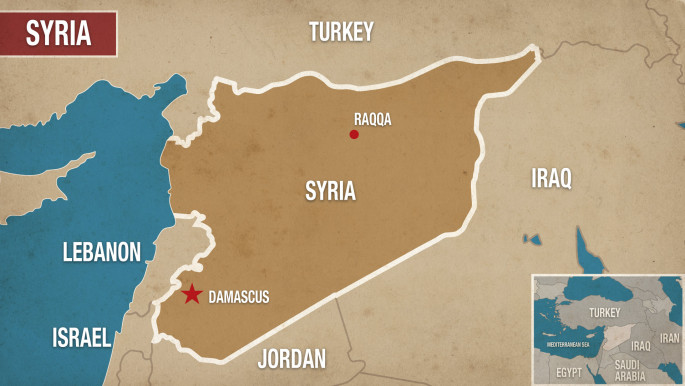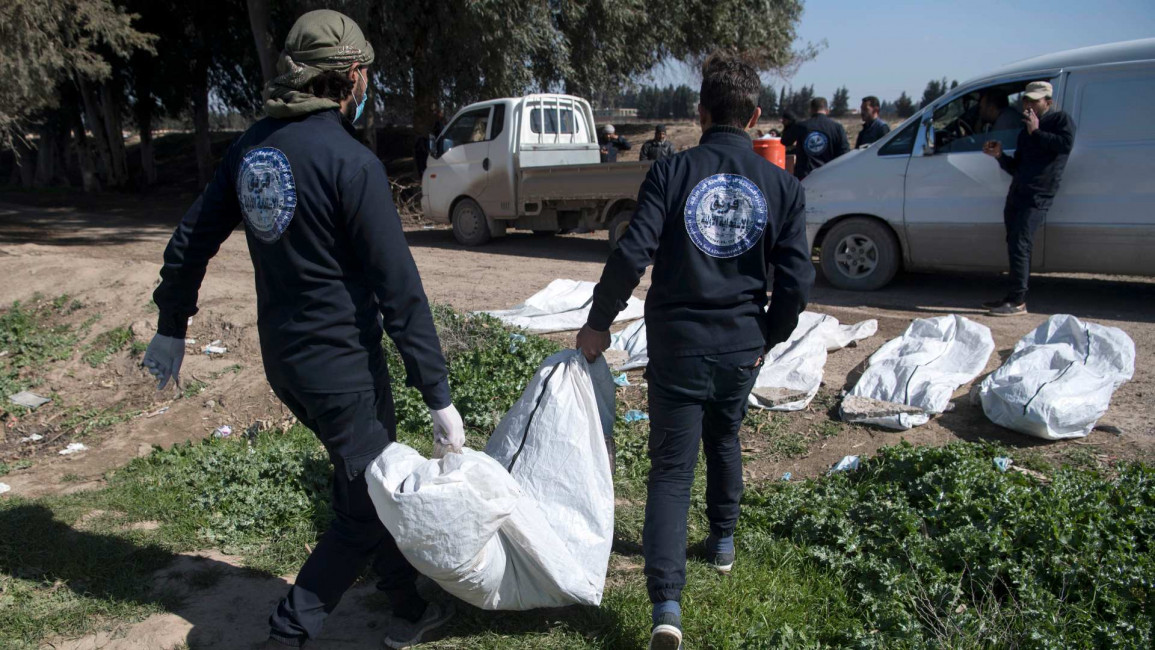IS used 50-metre deep gorge as 'dumping ground' for its victims in Syria, investigation reveals
IS used 50-metre deep gorge as 'dumping ground' for its victims in Syria, investigation reveals
Human Rights Watch's investigation unearths evidence on how IS used northeastern Syria's al-Hota gorge as a mass grave for those it abducted or detained.
3 min read
Raqqa's civil defence excavate a mass grave of IS victims in 2019 [Getty]
A new investigation has revealed how the Islamic State group used a 50-metre deep gorge to dispose of the bodies of countless victims while it controlled swathes of northern Syria between 2013 and 2015.
The report compiled by Human Rights Watch (HRW), which was published on Monday, uses drone footage, interviews with locals, and analysis of IS videos and satellite imagery to expose the horrors at Al-Hota gorge in northeastern Syria.
HRW said that the findings must be used to pressure authorities into securing the site, removing the human remains, and preserving evidence that can be used in criminal proceedings against the militant group.
Sara Kayyali, Syria researcher at HRW, said in a statement: "Al-Hota gorge, once a beautiful natural site, has become a place of horror and reckoning."
"Exposing what happened there, and at the other mass graves in Syria, is crucial to determining what happened to the thousands of the people ISIS executed and holding their killers to account," she added.
The gorge lies 85 kilometres north of Raqqa city, the former capital of IS' so-called caliphate, which it controlled from 2013 to 2015.
Syria Weekly: Rami Makhlouf's fall from grace confirmed following video plea to Assad
The area surrounding Al-Hota is currently under the control of the Turkish-backed Syrian National Army, while Raqqa is administered by the Kurdish-led Syrian Democratic Forces.
"Whoever controls the gorge has an obligation to preserve the site, identify the missing, and investigate their deaths," said HRW's statement.
Across former IS territories in Syria, more than 20 mass graves have been unearthed, containing thousands of bodies of the group's victims.
According to HRW's investigation, IS would threaten locals with being thrown into Al-Hota. Locals also reported having seen bodies strewn around the gorge's edge.
A video posted by IS on Facebook in 2014 shows a group of men throwing two bodies into the canyon. HRW identified the clothes worn by the victims as matching those worn by two men executed by IS in a previous video.
A drone sent into the gorge revealed six corpses floating in water at the bottom, however a topographic model of the area shows that the gorge goes deeper than the drone was able to travel, and that more bodies are likely under the water's surface.
The level of decomposition suggested the bodies found had been dumped there long after IS had ceded control of the area. Local residents reported hearsay about anti-regime groups throwing bodies of regime soldiers and pro-regime militia fighters in the gorge, but this could not be verified.
Under IS rule in Syria, thousands of people were abducted and detained, many of them executed.
Earlier this month, the Kurdish-led Syrian Democratic Council (SDC), a civilian authority currently in parts of northeast Syria reclaimed from IS, announced the creation of a taskforce to track what happened to those IS abducted and detained.
However the SDC is unlikely to be granted access to areas controlled by Turkey its allied factions due to hostility between the two sides.
HRW urged Turkish and Kurdish authorities to treat Al-Hota and other mass graves as crime scenes and not destroy any evidence, while clearing the areas of mines and other obstructions to investigators.
"Whichever authority controls the al-Hota area is obliged to protect and preserve the site," Kayyali said. "They should facilitate the collection of evidence to hold ISIS members accountable for their horrendous crimes, as well as those who dumped bodies in Al-Hota before or after the ISIS rule."
Follow us on Facebook, Twitter and Instagram to stay connected
The report compiled by Human Rights Watch (HRW), which was published on Monday, uses drone footage, interviews with locals, and analysis of IS videos and satellite imagery to expose the horrors at Al-Hota gorge in northeastern Syria.
HRW said that the findings must be used to pressure authorities into securing the site, removing the human remains, and preserving evidence that can be used in criminal proceedings against the militant group.
Sara Kayyali, Syria researcher at HRW, said in a statement: "Al-Hota gorge, once a beautiful natural site, has become a place of horror and reckoning."
"Exposing what happened there, and at the other mass graves in Syria, is crucial to determining what happened to the thousands of the people ISIS executed and holding their killers to account," she added.
The gorge lies 85 kilometres north of Raqqa city, the former capital of IS' so-called caliphate, which it controlled from 2013 to 2015.
Syria Weekly: Rami Makhlouf's fall from grace confirmed following video plea to Assad
The area surrounding Al-Hota is currently under the control of the Turkish-backed Syrian National Army, while Raqqa is administered by the Kurdish-led Syrian Democratic Forces.
 |
|
| Click to enlarge |
"Whoever controls the gorge has an obligation to preserve the site, identify the missing, and investigate their deaths," said HRW's statement.
Across former IS territories in Syria, more than 20 mass graves have been unearthed, containing thousands of bodies of the group's victims.
According to HRW's investigation, IS would threaten locals with being thrown into Al-Hota. Locals also reported having seen bodies strewn around the gorge's edge.
A video posted by IS on Facebook in 2014 shows a group of men throwing two bodies into the canyon. HRW identified the clothes worn by the victims as matching those worn by two men executed by IS in a previous video.
A drone sent into the gorge revealed six corpses floating in water at the bottom, however a topographic model of the area shows that the gorge goes deeper than the drone was able to travel, and that more bodies are likely under the water's surface.
Twitter Post
|
The level of decomposition suggested the bodies found had been dumped there long after IS had ceded control of the area. Local residents reported hearsay about anti-regime groups throwing bodies of regime soldiers and pro-regime militia fighters in the gorge, but this could not be verified.
Under IS rule in Syria, thousands of people were abducted and detained, many of them executed.
Earlier this month, the Kurdish-led Syrian Democratic Council (SDC), a civilian authority currently in parts of northeast Syria reclaimed from IS, announced the creation of a taskforce to track what happened to those IS abducted and detained.
However the SDC is unlikely to be granted access to areas controlled by Turkey its allied factions due to hostility between the two sides.
HRW urged Turkish and Kurdish authorities to treat Al-Hota and other mass graves as crime scenes and not destroy any evidence, while clearing the areas of mines and other obstructions to investigators.
"Whichever authority controls the al-Hota area is obliged to protect and preserve the site," Kayyali said. "They should facilitate the collection of evidence to hold ISIS members accountable for their horrendous crimes, as well as those who dumped bodies in Al-Hota before or after the ISIS rule."
Follow us on Facebook, Twitter and Instagram to stay connected



